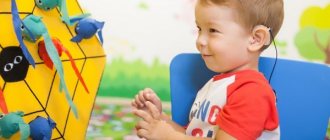Stages of development of a child’s own (expressive) speech:
Screams
- arise from birth.
Booming
– prolonged pronunciation of vowels and syllables with throat consonants (gu, agu, gee) from 2 to 5-7 months.
Against the background of a melodious hum, syllables with labial and anterior lingual sounds appear
, which then transform into babble.
Babbling
– repeated repetition of syllables, with labial and frontal consonants (ma-ma-ma, boo-boo-boo) began from 4-7.5 months.
Words
- the transition is carried out against the background of ongoing babbling: babbling words (mom, dad, bobo, bang, am, give) from 11-12 months.
The appearance of words in the adult lexicon (milk - moko, mami - take, maka - small, titiki - watch) began at 1 year 7/9 months. The coexistence of words, correctly and incorrectly pronounced, is the main pattern of the initial stages of speech development in children.
How to stimulate speech
Speech abilities are better formed when the child has well-developed fine motor skills. There are acupuncture points on the palms that are connected to the speech centers of the brain. Fine motor skills in young children can be developed in the following ways:
- Massage your palms regularly.
- Often play “okay-pancakes”.
- Bend and straighten your fingers, while counting how many there are on your hands.
- Place the baby on his stomach, placing a structured mat under his arms.
To teach a child to speak, in addition to daily activities to develop fine motor skills, you need to engage in speech games with him.
Babies aged two months and older can sing nursery rhymes consisting of short words. When a baby gurgles, adults can clearly repeat the sounds he makes. The baby will want to answer. The result is a fun activity that will delight your child. When the child grows up, the game can be complicated by pronouncing syllable chains - “ma-ma”, “ba-ba”, “au-au”.
By the age of one year, the baby will already be able to pronounce whole words. Some children at this age do not live up to their parents' expectations, and all attempts to teach them to speak seem to be in vain. Much depends on the individual characteristics of a particular baby. Some start talking early, progressing from repeating syllables, words, and then sentences. Others remain stubbornly silent for a long time, uttering only individual sounds, but then begin to speak immediately, in whole sentences, so that parents do not have time to keep track of new words.
There are no rigid frameworks defining how many words and what letters a small child should pronounce. An incomplete range of sounds up to 2-3 years is the norm. If a child does not have mental retardation, he understands the speech of adults well and reacts correctly to their words, then there is no reason for alarm.
Growth of a child’s vocabulary from one year and older
- 1 year - 5-9 words
- 1.5 years from 20 to 40 (from different authors)
- 2 years from 50 to 200 words
- 3 years from 800 to 1000 words
- 3.5 years - 1100
- 4 years 1600 - 1900
- 5 years 1900 – 2200
Development of phrasal speech
The appearance of phrases from two lexical units (Lala bah, papa am) begins from 1 year 9 months to two years.
The emergence and development of proposals - from two years.
By the age of 3, he begins to use complex subordinate clauses, questions “why?” appear. “when?”, uses almost all parts of speech, prepositions and conjunctions.
Uses singular and plural.
By the age of four, speech is grammatically correct, suffixes and more complex phrases are used.
Further development of speech is assessed mainly not by the number of words, but by the ability to answer questions, the presence of initiative in a conversation, the construction of logical chains, the ability to compose a story from a picture, talk about an event, retell a fairy tale.
At the same time, understanding of complex grammatical structures is assessed.
Problems in speech development
In what cases might you need to consult a specialist?
- The child is silent for several days, although before that he actively gurgled and cooed.
- The baby did not start walking, although he was already 3-4 months old.
- The baby is cooing, but the sounds it makes sound abruptly and bear little resemblance to cooing.
- Humming resembles a squeal.
- The child does not conduct a “dialogue” with adults and makes random sounds.
Such symptoms should alert you. It is important for parents to take appropriate action in time and make an appointment with a good neurologist with their child.
What to do if your child stops walking
Humming and babbling are the first sounds that allow a baby to communicate with the world of adults. When a child suddenly stops talking, parents feel uneasy.
The cause of such changes can be both pathological and physiological factors. At the age of 4 months, infant sounds are replaced by baby babble. The speech apparatus is actively preparing to reproduce the first words, the baby begins to pronounce drawn-out, loud sounds, laugh, and squeal. Perhaps a short pause simply precedes the next stage in speech development.
A temporary cessation of partying is often caused by a change of environment, stress or lack of attention.
Pathological reasons:
- underdevelopment of facial muscles;
- hearing problems;
- complications after illness;
- neurological pathologies;
- mental retardation.
Only a doctor can identify possible problems. If the child stops making sounds and the humming does not occur for more than 2 weeks, you need to consult a specialist; most problems can be easily corrected with the help of medications. But even during this period, do not stop communicating with the baby.
Lesson or communication?
Of course, when communicating with a child, we teach him one way or another. But try not to let your desire to teach your baby literally from the cradle overshadow a more important thing - your live emotional communication.
Photo: ShevtsovaYuliya / freepik.com
If you follow the theories of early development, you probably heard the name of the American scientist Glen Doman, who argued that, being in a special learning environment from a very early age, a child can achieve very high intellectual results. At his Institute of Child Development, Doman conducted many experiments, the essence of which boiled down to the following. Beginning at two months of age, when their eyes begin to focus, infants were rapidly shown various cards depicting letters, words, notes, numbers, pictures, hieroglyphs and much, much more. During the demonstration, the teacher or mother named the corresponding object. At first, such “lessons” lasted 5-10 minutes, then their duration gradually increased.
When the kids grew up, this is what became clear. They really remembered information perfectly, spoke foreign languages, read, counted, etc. But at the same time, the kids did not play at all; their emotional sphere was disturbed. Accustomed to only passively absorbing didactic material, they did not strive for active knowledge of the world around them; creativity was inaccessible to them, since they had no real creative experience. And they could not always put into practice that huge store of knowledge that their tenacious childhood memory stored. The saddest thing is that the emotional disturbances in these children were already irreparable. After all, many very important milestones of emotional development are laid precisely in infancy, when the child wants and can communicate, build social models of behavior, and not record countless dry facts in his brain.
In my psychological practice there was a boy, Andryusha, who could not adequately communicate with his peers. He ran in circles, constantly repeating the same phrase. At the same time, he had very big problems with the articulation of sounds: at the age of five he simply could not pronounce about fourteen sounds, so it was difficult to understand him. He preferred to communicate in writing.
It turned out that Andryushin’s mother was at one time very interested in the early intellectual development of her son. As a result, he learned to read before he spoke. At the same time, he did not play, studying numbers, letters, special cards, and only drew geographical maps.
When starting to teach your child letters in infancy using a newfangled developmental method, be careful! Some children who were taught to read, for example, using Zaitsev's cubes before they began to speak, had delayed speech development. Instead of engaging in live communication, they read and wrote using blocks.
How children learn to pronounce their first words
Even a child who is not yet talking actually understands more than you think. Your baby also successfully communicates in a variety of ways: crying to let you know he's hungry, cooing when he's happy, pointing at a toy he wants, and turning away from food he doesn't like. Such communication with gestures and sounds is the foundation for the development of speech. Young children learn to speak by listening to adults and older children speak. Babies prefer the human voice to all other sounds, and the most favorite and soothing sound is the voice of their parents. Babies often react especially attentively to high-pitched voices. You may have noticed that when talking to a child, you use a higher tone than when talking to adults. High tone, expressive articulation and facial expressions arouse the child’s interest and contribute to the development of speech.
What can you do if there is no partying?
It is necessary to stimulate the senses from birth. Talk to your child more often, tell him what you are doing at the moment, ask questions, even if he cannot answer them yet.
You can be sure: he listens carefully to everything and will soon puzzle you with an answer. Repeat baby talk after him, sing or read aloud.
But, it is important not only to talk to the child, but also to listen. After all, every syllable in his vocabulary means something. If he uses the combination “ko” when he sees a cat, say: “Yes, it’s a cat!” The baby must understand that he is being listened to; this will stimulate him to learn more and more new words.
Each child's babbling appears at different ages; parents should be patient. A slight delay in speech should not be scary; at this time, a passive vocabulary is being formed.
Rules to help stimulate speech and walking:
- When speaking, use simple, short sentences. Speak slowly, clearly, and demonstrate correct articulation.
- Give up "lisping." When communicating with a child, do not distort your words; baby talk should be used as little as possible, only in moments of tenderness.
- Develop fine motor skills. Give your baby rattles made of various materials, massage his hands, working on each finger individually.
- Talk more, comment on all actions: “Well done, Mashenka. I ate porridge. What was the porridge like? Delicious! Now let's go for a walk..."
- To stimulate humming, make sounds similar to it, then give the baby the opportunity to answer you. While communicating, pet him and smile.
- When your baby is awake, play him recordings of children walking or adults imitating walking. This method is designed to evoke an early imitative reflex.
- An important condition for the correct development of pre-speech reaction is visual communication. The baby must clearly see the adult’s face in order to peer into his facial expressions and articulation.
Varieties of humming
Gumming is the pronunciation of chains of various vowel sounds (a, u, y), sometimes in combination with similar consonants (m, g). Usually these sounds are associated with an emotionally positive state.
Up to 3 months, humming does not depend on auditory perception; later, pronunciation occurs under the control of hearing.
Experts distinguish two periods of humming:
- "Hooting." Characterized by short and abrupt vocal responses.
- "Pipe". It is the utterance of a chain of alternating sounds.
Interesting! Children with a lack of hearing also go through all stages of humming and even begin to babble. But without receiving auditory reinforcement, they lose this ability.
When a child starts to smile
Many parents notice a smile on the face of a newborn in the first days of life. More often this happens during sleep or during feeding. But this is not yet a way to express emotions. Doctors believe that this happens reflexively. A newly born baby does not yet know how to express emotions and feelings.
Parents and doctors confirm that the first conscious smile appears a month after birth. Moreover, this happens to all children at different times. It is impossible to name the exact date when the baby will smile for the first time.
However, it is possible to name the time period during which the baby should begin to smile in response to external stimuli. The norm is considered to be a baby's age from 4 to 8 weeks from birth.
When (at what age) does a child start to gurgle and coo?
Before birth, children hear their mother’s heartbeat and voice in the womb, and train their hearing. After the 28th week of pregnancy, the hearing of the unborn child is already fully developed. A mother who speaks to her unborn baby lays the foundation for the development of its language.
After birth, children want to communicate and can do this in different ways:
- A cry is the first sound, the strongest expression of a newborn’s feelings in the first months of life. It contains two vowels “u” and “a”.
- The baby uses body language, changes facial expression, grunts, smiles, frowns.
- In visual contact with the mother’s eyes, the child “says” how he feels, whether he feels good or uncomfortable, whether he wants to eat or rest.
- The baby, exchanging glances with his parents, feels that he can communicate and change something in his environment, that this is pleasant and fun.
- Attentive parents intuitively “read” messages, interpret “statements,” ignore or respond to them.
In the first 4 weeks of life, a newborn improves the ability to distinguish voices and intonations. Unconscious cooing appears.
After 2 months, the baby understands that there is a connection between his state of mind and the appeal to him. For example, if he behaves restlessly, he hears comforting, soothing intonations in his mother’s voice.
On a note! Babies begin to make their first cooing sounds between the sixth and eighth weeks of life. They are pronounced very softly, with a guttural pronunciation. Some sociable children may begin to coo as early as one month of age.
A little later, the child begins to learn to connect the events happening around him with the language of communication. At the age of 3–4 months, he can recognize his name, understand, and have a friendly facial expression and tone.
Gradually, the baby begins to understand that a dissatisfied facial expression is associated with an annoying-sounding voice, and a smiling face is associated with a friendly-sounding one.
The first stage is screaming
When a baby is born, coming from one environment to another, he needs to somehow declare himself, his presence in this world. While the child was in the mother's belly, all his needs were satisfied instantly. Now he sometimes feels some kind of discomfort - and screams (still at the level of an unconditioned reflex). When the baby's needs are met, the child develops a certain behavioral stereotype, and the cry becomes a signal of discomfort (wet, wants to eat or sleep, sad, lonely). The child has only one remedy - screaming. Gradually, with the help of a cry, the baby learns not only to attract attention to himself, but also to communicate. Remember, when your baby calls you, he first screams and then waits for an answer: will mommy come or not? Then he screams louder and waits again. In this way, the child gives his “interlocutor” the opportunity to engage in his first dialogue.
Photo: nastyaofly / freepik.com
Around the third month (and for many babies much earlier), the intonation of screams also changes. An attentive mother can identify many different cries of her child - it could be grumbling, whining, dissatisfaction, a sharp squeal of pain, angry “exclamations”.
“Even if I’m in another room, I can almost certainly tell from the screams what’s happening to my twins. When they quarrel and cannot share toys, the cry is the same; when they are bored, the cry is completely different. And, of course, I always distinguish shrill and sharp “dangerous screams” (when you urgently need to run to help) from “non-dangerous” ones, when children simply express their dissatisfaction.”
The cry is present in the child for quite a long time, developing in parallel with speech. And even when real, “adult” words appear, screaming continues to play a very important role in communication.







